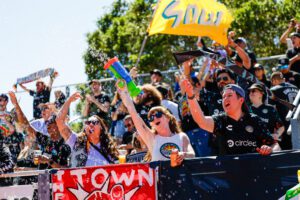Successful sponsored events can create a direct relationship with a consumer and leave an indelible imprint, resonating for years.
Live events stir emotions, producing powerful human connections that transform an individual’s relationship with the brand. This is why global brands have been shifting their marketing dollars away from traditional advertising in favor of experiential marketing. For a generation of streamers who consume media on their own time, a unique in person experience is a shareable moment, and for big business an opportunity to develop deep personal connections with consumers.
 While experiential marketing may be one of the oldest marketing channels, it integrates well with new media. Events offer businesses an opportunity to showcase videos, screen relevant content, distribute printed material and amplify their social channels. Events deliver Instagrammable moments, which get shared peer to peer and generate story lines that attract media.
While experiential marketing may be one of the oldest marketing channels, it integrates well with new media. Events offer businesses an opportunity to showcase videos, screen relevant content, distribute printed material and amplify their social channels. Events deliver Instagrammable moments, which get shared peer to peer and generate story lines that attract media.
Images from experiential events tend to find permanent homes on smartphones. They become a living testimonial for the brand, providing real, authentic moments that drive consumer engagement and build brand loyalty. It is why so many corporations have increased their budget for brand activation spending and why marketers should be paying attention.
You May Also Enjoy:
- Memorable Events Help Sophos Engage B2B Customers
- Subaru Roams the Great Outdoors With Unique Events Promotions
How does creating a branded event translate into your marketing goals? It gives brand stewards the opportunity to create a multi-tiered strategy, one of action and reward. Offering rewards for action has a positive psychological effect on attendees, creating cravings and desires that the brain’s neural pathways translate into positive emotions. In effect you are using the experience of live events to hook customers into habits that benefit a brand through rewards. Consumers can be motivated to share socially through incentives like winning a must have product or a ticket to a VIP or influencers only event. The more action, the greater the reward.
Some things never change. Marketers still need to know what compels and drives their target audience, how to capture their imaginations, and inspire them to action. Creating an experiential event needn’t be complicated; sometimes simplicity speaks volumes. Give consumers the opportunity to try products in a multisensory way. Capture it in slow-motion and make it exclusively available to brand loyalists. Create powerful human experiences, with messages that matter. Your target audience wants to be at the center of it all, a place where others cannot enter. They want to get their hands dirty in maker spaces. They want to learn from experts, and feel connected to the brand. Surprise them with concerts and activities that help tell your story and that are culturally relevant. You are beginning a relationship with people poised to become future brand ambassadors…what will you do with it?
How do you measure success? It starts early in the process. First, fully define goals and objectives. Then establish a baseline, know all of the costs associated with the event, and devise ways to capture data. Once the event is complete you will need to offset the costs by your established goals. It can be measured simply through direct sales, consumer newsletter signups, registrations for news on future events, shared social posts, or earned media generated from your event.
However, there are high-tech solutions that can provide data on a consumer or attendee’s journey through an event through RFID tokens. By tracking the consumer’s experience, you can build dynamic profiles that can be segmented and used to direct market and retarget. There are ways to implement software solutions that utilize an API feed to capture data and populate CRM platforms, which will assist with automation. While metrics and goals may vary for each organization, the ultimate objective remains the same, investing in relationships that can last a lifetime.
Jennifer Kurland is a founding partner of productionglue.

 Network
Network

